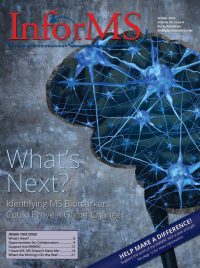
Research efforts at the Rocky Mountain MS Center at University of Colorado have been at the forefront of multiple sclerosis care and treatment for decades, but in all those years there’s never been a time where a fundamental change to the MS landscape has been so close.
Thanks to generous donor support leading to the purchase of new technology, research efforts are underway that could have a profound effect on MS — from the speed at which we can diagnose it, to our ability to monitor it, and to the effectiveness with which our treatments work.
The Rocky Mountain Translational Neurology Laboratory — established this year to advance biomarker research and further the development of a vaccine approach to preventing MS — is now up, running, and pushing its research efforts forward.
The basic idea here isn’t new: use biomarkers to detect, monitor and make treatment decisions. What’s different — and what’s directing these promising new pathways in research — is the sensitivity of this new technology for detecting rare molecules that may allow neurologists to monitor what is going on in the brain using a simple blood test.
Put it all together, and we’re on the cusp of having a truly unprecedented way to see exactly what MS is doing in an individual’s brain, information that can transform the way we make treatment decisions for MS patients.
“We’ve purchased the Quanterix SIMOA machine to perform sophisticated and ultra-sensitive biomarker studies using blood samples,” says Dr. Timothy Vollmer, Medical Director of the RMMSC and Co-Director of the RMMSC at CU. “This machine has proven ability to detect very rare molecules in biospecimens of many types, and is allowing us to move rapidly forward with the biomarker studies.”
“My view is this may allow us to do away with the need to do annual MRIs,” says Dr. Vollmer. “Instead we’ll be able to follow up on biomarkers in the blood. We have some good data now that they may be more sensitive, and more predictive of ongoing disease activity and increasing disability in MS.”
“We run blood tests when patients come to clinic to see us every six months anyways,” he said. “So it defragments their care. But more importantly, it gives us more information. Neurologists use MRIs as though they are telling us everything we need to know about MS, but they don’t. MRIs don’t detect slow changes, which is the major problem for us.”
“The Translational Lab and technology are allowing us to ask questions that we have never been able to ask before.”
What is a Biomarker?
A biomarker is a measurable indicator that can reliably and accurately tell us about a biological state or medical condition.
One of the most familiar examples of a biomarker is blood cholesterol, which is known to predict a person’s risk for coronary heart disease. A simple blood test can measure the amount and types of cholesterol in your blood, and with that information, your physician can predict your risk and decide if a treatment plan is necessary.
If you’ve ever had a lumbar puncture or spinal tap related to your MS diagnosis, your neurologist was looking for a biomarker — specifically, the presence of certain antibodies in your spinal fluid that are known to indicate MS activity.
Testing spinal fluid has long been considered a reasonably accurate tool in helping diagnose MS, but it’s not without its drawbacks. First and foremost, a lumbar puncture isn’t a very pleasant experience for the patient. Aside from that, the presence of the antibodies doctors are looking for tells them that MS is present — and likely has been for some time. But it can’t help determine changes, disease progression, or worsening of MS.
Recent research has been aimed at broadening the scope of biomarkers related to MS. What was once a relatively simple diagnostic tool may change the landscape of MS in the not-too-distant future.
“Biomarkers are going to impact diagnosis, they’re going to impact monitoring treatment response, they’re going to impact how safely we can take people off drugs,” says Dr. Vollmer “They’re also going to impact the development of new drugs, particularly combination drugs, drugs that are neuroprotective and potentially can induce some neurorepair.”
New understanding of the biology of MS and recent technological advancements are coming together to open a whole new range of potential biomarkers that may be relevant to MS. The research team at the RMMSC at CU is hard at work determining which biomarkers we can see, where we can see them, and exactly what they can tell us about the disease.
“Having these markers would dramatically speed up the whole process of developing neuroprotective or neuroreparative therapies,” says Dr. Vollmer, “because up until now we didn’t have any way to really see repair in the brain in a way that’s sensitive to allow us to do faster studies. You can’t really see that on MRI. The best you can do are functional MRIs but they can be very hard to interpret.”
The lumbar tests mentioned earlier tell us when certain antibodies are present in spinal fluid, and we know that to be an indicator of MS activity. New biomarkers and advanced ways to see them could go far beyond that limited view.
“New technology allows us to monitor what’s going on in the different cellular compartments of the brain,” says Dr. Vollmer. “We also look at the immune compartments simultaneously. We’re sort of dissecting the brain without actually having to cut into it. It gives us significant opportunities.”
For patients, the impact is clear: more sensitive tests mean more clear results, and the ability to see the tiniest levels of disease activity at the earliest stages mean quick and reliable diagnosis.
Better still, the most promising biomarker paths in MS look to be gleaned from blood tests, which could reduce or even end the need for doctors to rely on difficult and sometimes painful lumbar punctures.
Can a simple blood test really help diagnose MS? The research is ongoing, but all signs are pointing that direction.
What’s In the Blood: Neurofilament Light
One area of this research concerns a protein produced when MS attacks certain cells in the nervous system.
“Many centers are looking at biomarkers right now, and the data does suggest that neurofilament light (NfL)is probably one of the most promising ones,” says Vollmer. “NfL is produced from nerve cells where the axon (the nerve fibers) are being damaged — it’s a structural protein that comes from axons. The data shows us that NfL, found in the blood, does indeed correlate with damage happening in the brain in MS and many other brain diseases.”
RMMSC at CU researchers have been comparing the results of NfL tests, hoping to see if levels in the blood can be as accurate as those in the spinal fluid. “So far we have analyzed about 120 different specimens of both spinal fluid and blood,” said Vollmer, “and we are looking at how the spinal fluid and blood correlate.”
“We are trying to understand the factors that make that correlation not as good as we would like,” said Vollmer. “For example, body size is one factor: bigger people actually have lower levels of NfL, they are diluting it in larger blood volumes.
Knowing that, we hope to be able to develop a formula that takes into account these characteristics so that we can get better correlation between the blood and spinal fluid.”
With more research, the aim is to develop a procedure that will ensure blood tests are reliable and accurate. “Our primary goal in the MS world is to get that information out of the routine blood sample that we can do in the clinic on our patients to monitor them, to actually be able to assess how much damage in the brain are they having and how are they doing on the medications,” says Dr. Vollmer. “In the future, we expect that we will assess the efficacy of the different drugs by looking at the level of NfL in the blood of the patient.”
Developing such a test will have far-reaching effects. “It also allows us monitor patients that are going off therapy, monitoring patients with blood samples to make sure they don’t reactivate their disease.”
“It’s also very relevant to neuromyelitis optica (NMO) and to Autoimmune Encephalitis,” said Dr. Vollmer. “This marker is going to allow us to move across the field of inflammatory brain disease and have better ways of seeing what’s going on.”
GFAP: Glial Fibrilary Acidic Protein
While NfL is produced by damaged axons, a second promising biomarker is more closely related to astrocytes — a type of glial cell in the nervous system that helps protection and repair of other nervous system cells. Increased levels of glial fibrillary acidic protein (GFAP) can indicate MS activity, possibly even earlier than other biomarkers.
“GFAP comes from astrocytes, not neurons. Neurons don’t carry GFAP,” says Vollmer. “We’ve found that GFAP was also elevated in the blood of MS patients at the time we first diagnose them. These patients are not yet on therapy — they came in and had a spinal tap done as part of the diagnosis.”
“That gives us a chance to look in the astrocyte compartment. That’s important because there is increasing evidence that when B lymphocytes activate in the brain, they change the behavior of astrocytes, and the astrocytes then lead to the death of neurons and myelin-forming cells.”
“Myelin-forming cells and neurons appear to be killed as sort of bystanders in the process,” said Vollmer. “They get killed because these astrocytes turn into inflammatory cells that are producing a lot of toxic molecules including nitric oxide and TNF, a protein involved in inflammation. We have really good evidence of this because some of the disease modifying therapies — including Gilenya, Mayzent, and Tecfidera — work through inhibiting these astrocytes.”
“Most of the world thinks that those drugs work by lowering the number of lymphocytes in the blood, but one very well-done study shows us that they are actually working through astrocytes,” said Vollmer. “The blood marker allows us to ask the question: When we put people on highly effective therapies like ocrelizumab, rituximab, and natalizumab, do we really shut off the disease completely? Or is there still ongoing injury inside the blood brain barrier that these drugs can’t get at?”
To help answer these questions, RMMSC researchers are looking at a number of patients when they first start on highly effective therapies, and then again every six months.
“We are trying to understand when the activated astrocytes and the NfL levels begin to normalize,” says Dr. Vollmer. “And if they are not normalizing right away, then that gives us an opportunity to look at adding some of these medications that work at the level of astrocytes, on to ocrelizumab and rituximab to see if we can accelerate the response to treatment.”
What About Progressive MS Research?
“We’re in the process of developing newer assays that look at what’s happening with myelin, too,” said Dr. Vollmer. “We look at myelin basic protein (MBP) and other potential markers of myelin injury.”
“The studies that we’re doing right now with the SIMOA technology — looking at these biomarkers, and understanding how sensitive and specific they are — may allow us to then do phase one studies where we also have an efficacy outcome,” said Dr. Vollmer. “Phase one is usually just looking at safety, because you don’t have enough people there to really get an answer about treatment. But with this technology we could get a pretty good hint of what the drug is doing. This speeds up research because we can go in for multiple trials at once.”
A promising development in neurorepair is a recent study where a common diabetes drug called Metformin was shown to recover function in mice with an MS-like disease. “Having this technology could allow us to do an add-on study with Metformin next year,” said Dr. Vollmer, speeding up the usual process of testing and delivering results far more quickly than has ever been possible.
MS Research Benefits Other Disciplines
Developments at the Translational Lab aren’t confined to the MS world. In fact, much of the testing that’s able to be done with this new technology is showing great promise for other areas as well.
“We’re also working on these markers and introducing them to our colleagues in other disciplines such as epilepsy, stroke, and movement disorders,” says Dr. Vollmer, “because we think they will be useful for them. We already know they are useful in traumatic brain injury (TBI). In TBI, the level of NfL in the blood correlates with the outcomes of patients that have TBI.”
“Autoimmune Encephalitis patients can benefit from this technology in helping us develop better therapeutic strategies,” says Dr. Vollmer, “since there are no FDA approved therapeutic strategies for them.”
Allowing Better Treatment Decisions
The hope is that once a sophisticated, reliable panel of biomarkers is available for gathering detailed data on what’s going on in the brains of individuals with MS, that using this information will give us answers more quickly and easily than before. And with a finely-tuned, detailed view of exactly what’s going on in the brain, those treatment decisions can be made more safely.
“It’s a way for us to go back as a field and be able look more carefully at what we do to patients with many different neurologic diseases,” said Dr. Vollmer.
Personalizing Medicine in MS
Ultimately, the end goal of treating MS is to develop strategies based on truly personalized medicine — specific, detailed treatment decisions for each patient, based on a deep understanding of the exact course of their disease. More detailed than standard lab tests and more specific than MRIs, biomarkers offer the promise of just that.






